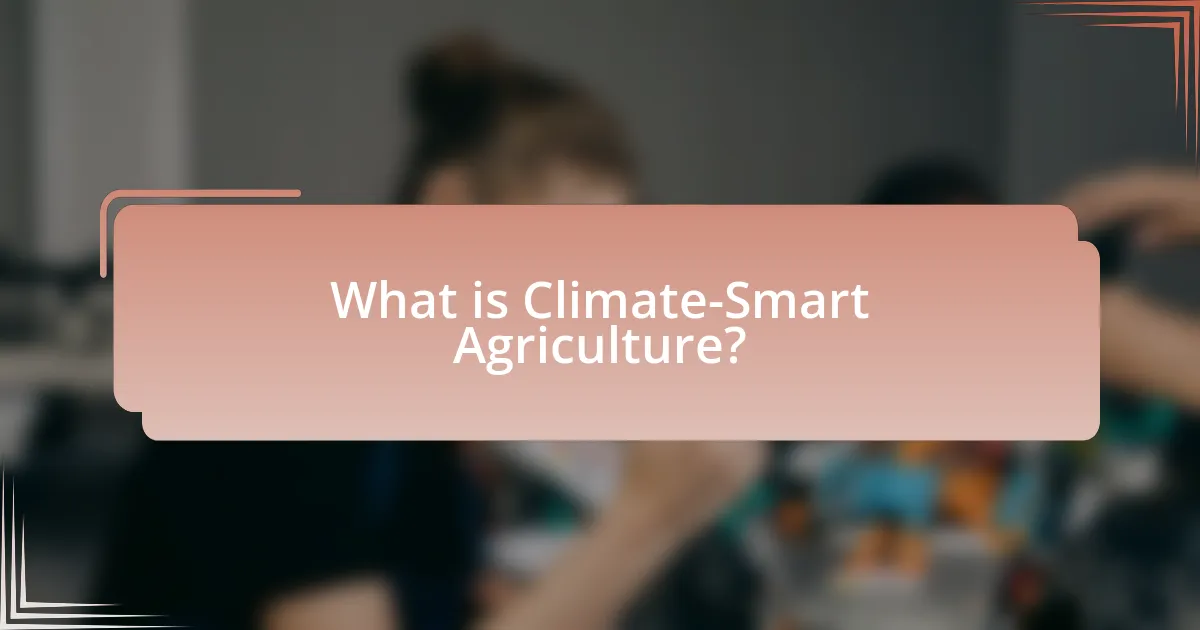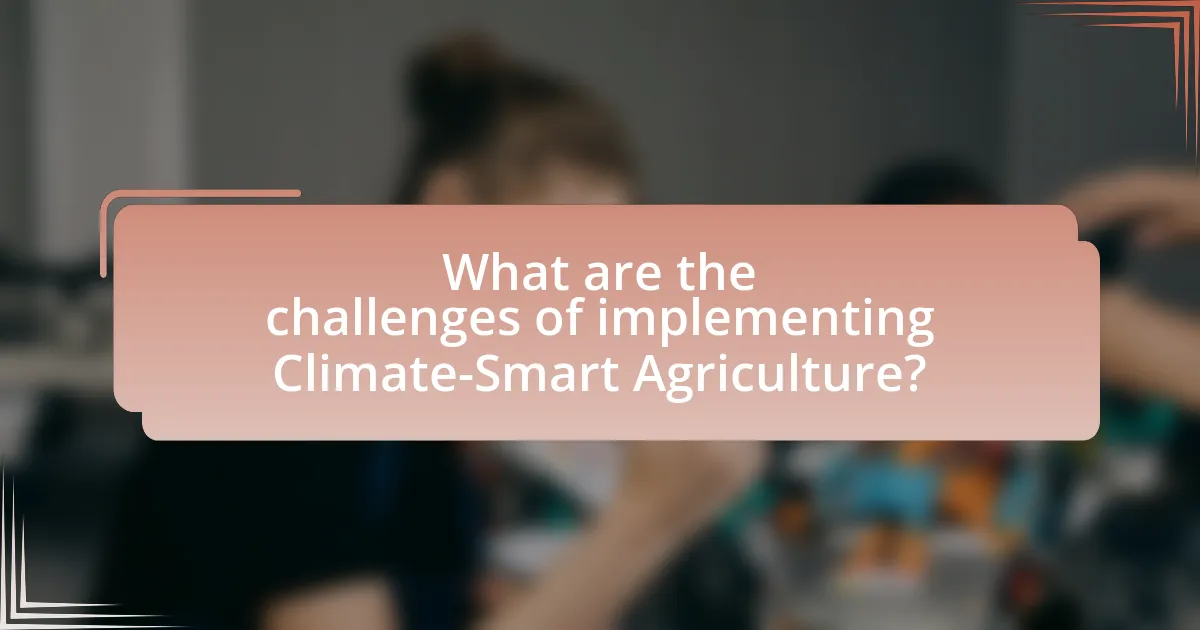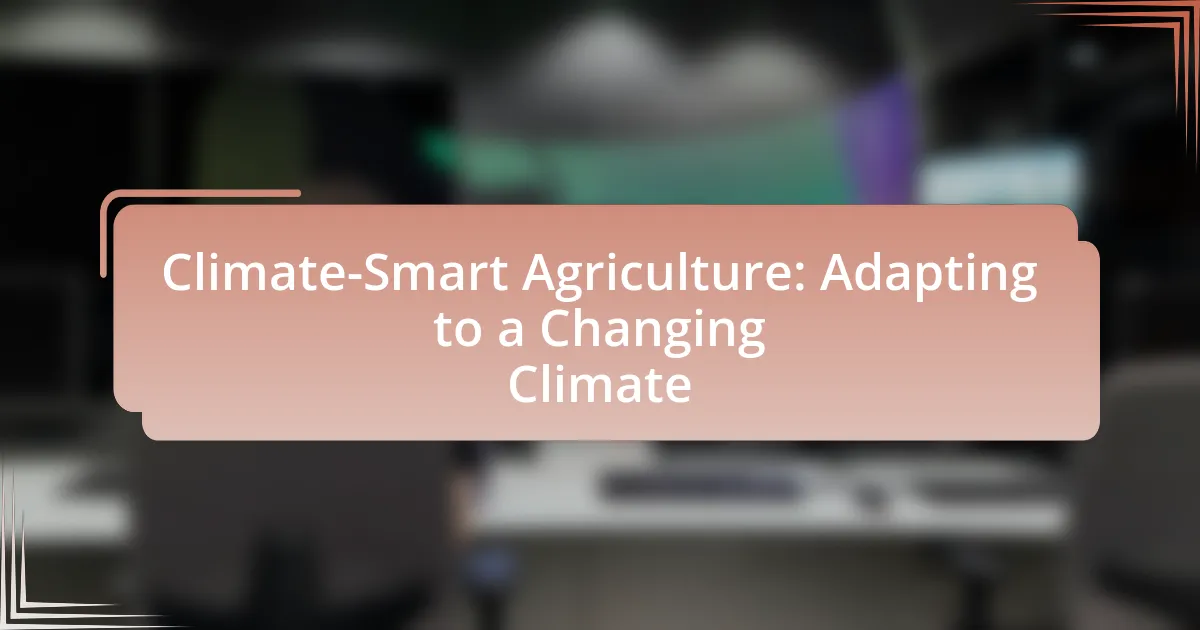Climate-Smart Agriculture (CSA) is a sustainable farming approach designed to enhance productivity, resilience to climate change, and reduce greenhouse gas emissions. The article outlines the principles and practices of CSA, including crop diversification, agroforestry, and efficient water management, which contribute to food security and environmental sustainability. It also discusses the challenges farmers face in adopting CSA, such as financial constraints and lack of training, while highlighting the importance of education, technology, and international collaboration in promoting these practices. Additionally, the article emphasizes the future prospects of CSA in addressing climate change impacts and ensuring agricultural sustainability.

What is Climate-Smart Agriculture?
Climate-Smart Agriculture (CSA) is an approach to farming that aims to increase productivity while enhancing resilience to climate change and reducing greenhouse gas emissions. CSA integrates sustainable agricultural practices, such as crop diversification, improved soil management, and efficient water use, to achieve food security and environmental sustainability. According to the Food and Agriculture Organization (FAO), CSA can help farmers adapt to climate variability, improve their livelihoods, and contribute to climate change mitigation by sequestering carbon in soils and reducing emissions from agricultural practices.
How does Climate-Smart Agriculture contribute to sustainability?
Climate-Smart Agriculture (CSA) contributes to sustainability by enhancing agricultural productivity while reducing greenhouse gas emissions and increasing resilience to climate change. CSA practices, such as improved crop varieties, efficient water management, and agroforestry, lead to higher yields and better resource use efficiency. For instance, a study by the Food and Agriculture Organization (FAO) indicates that implementing CSA can increase crop yields by 20-30% while simultaneously reducing emissions by up to 30%. This dual benefit supports food security and environmental health, making CSA a vital approach for sustainable agricultural development.
What are the key principles of Climate-Smart Agriculture?
The key principles of Climate-Smart Agriculture (CSA) are to increase productivity sustainably, enhance resilience to climate change, and reduce greenhouse gas emissions. CSA aims to achieve food security and improved livelihoods while adapting agricultural practices to changing climate conditions. For instance, practices such as crop diversification, agroforestry, and improved soil management contribute to these principles by promoting biodiversity, enhancing soil health, and optimizing resource use, which collectively support sustainable agricultural productivity and climate resilience.
How does Climate-Smart Agriculture differ from traditional farming methods?
Climate-Smart Agriculture (CSA) differs from traditional farming methods primarily by its focus on sustainability and resilience to climate change. CSA integrates practices that enhance productivity while reducing greenhouse gas emissions and increasing the ability of agricultural systems to adapt to changing climate conditions. For instance, CSA promotes crop diversification, improved soil management, and efficient water use, which are not typically emphasized in traditional farming. According to the Food and Agriculture Organization (FAO), CSA practices can lead to a 20-30% increase in yields while simultaneously reducing emissions by up to 30% compared to conventional methods. This evidence underscores the effectiveness of CSA in addressing both food security and environmental sustainability.
Why is Climate-Smart Agriculture important in the context of climate change?
Climate-Smart Agriculture is important in the context of climate change because it enhances agricultural productivity while reducing greenhouse gas emissions and increasing resilience to climate impacts. This approach integrates sustainable practices that improve soil health, optimize water use, and promote biodiversity, which are essential for adapting to changing climatic conditions. For instance, the Food and Agriculture Organization (FAO) reports that implementing climate-smart practices can lead to a 20-30% increase in crop yields in vulnerable regions, thereby ensuring food security amidst climate variability.
What are the impacts of climate change on agriculture?
Climate change significantly impacts agriculture by altering weather patterns, reducing crop yields, and increasing the prevalence of pests and diseases. For instance, rising temperatures can lead to heat stress in crops, while changes in precipitation patterns can result in droughts or flooding, both of which negatively affect agricultural productivity. According to the Intergovernmental Panel on Climate Change (IPCC), global crop yields could decline by up to 25% by 2050 due to climate-related factors. Additionally, increased carbon dioxide levels may initially boost some crop growth, but the overall negative effects of climate change, such as soil degradation and water scarcity, outweigh these benefits.
How can Climate-Smart Agriculture mitigate these impacts?
Climate-Smart Agriculture can mitigate the impacts of climate change by enhancing resilience, increasing productivity, and reducing greenhouse gas emissions. This approach incorporates practices such as crop diversification, improved soil management, and efficient water use, which collectively strengthen agricultural systems against climate variability. For instance, according to the Food and Agriculture Organization (FAO), implementing climate-smart practices can lead to a 20-30% increase in crop yields while simultaneously reducing emissions by up to 30%. These strategies not only help farmers adapt to changing conditions but also contribute to food security and sustainable development.

What practices are involved in Climate-Smart Agriculture?
Climate-Smart Agriculture involves practices such as crop diversification, agroforestry, conservation tillage, integrated pest management, and efficient water management. These practices aim to enhance productivity while increasing resilience to climate change and reducing greenhouse gas emissions. For instance, crop diversification can improve soil health and reduce vulnerability to pests, while conservation tillage helps maintain soil structure and moisture. According to the Food and Agriculture Organization, implementing these practices can lead to increased food security and sustainable agricultural systems.
How do crop diversification and rotation enhance Climate-Smart Agriculture?
Crop diversification and rotation enhance Climate-Smart Agriculture by improving soil health, increasing biodiversity, and reducing pest and disease pressures. These practices lead to more resilient agricultural systems that can better withstand climate variability. For instance, rotating crops can break pest cycles and reduce the need for chemical inputs, which aligns with sustainable farming principles. Research indicates that diversified cropping systems can increase yields by 20-30% compared to monocultures, demonstrating their effectiveness in enhancing productivity while minimizing environmental impact.
What are the benefits of crop diversification?
Crop diversification enhances agricultural resilience and sustainability. By growing a variety of crops, farmers can reduce the risk of total crop failure due to pests, diseases, or climate variability. Research indicates that diversified cropping systems can improve soil health, increase biodiversity, and optimize resource use, leading to higher overall yields. For instance, a study published in the journal “Agriculture, Ecosystems & Environment” found that farms practicing crop diversification had up to 30% higher yields compared to monoculture systems, demonstrating the effectiveness of this approach in adapting to changing climate conditions.
How does crop rotation improve soil health?
Crop rotation improves soil health by enhancing nutrient availability, reducing soil erosion, and breaking pest and disease cycles. Different crops have varying nutrient requirements and root structures, which helps maintain soil fertility and structure. For example, legumes fix nitrogen in the soil, enriching it for subsequent crops. Research indicates that fields with diverse crop rotations can yield 10-20% more than monoculture systems, as shown in studies by the Rodale Institute. Additionally, rotating crops can decrease the prevalence of soil-borne diseases and pests, leading to healthier soil ecosystems.
What role does agroforestry play in Climate-Smart Agriculture?
Agroforestry plays a crucial role in Climate-Smart Agriculture by enhancing biodiversity, improving soil health, and increasing resilience to climate change. This integrated approach combines trees and shrubs with crops and livestock, which leads to improved carbon sequestration, reduced soil erosion, and better water management. Research indicates that agroforestry systems can sequester up to 30% more carbon compared to conventional agricultural practices, thereby mitigating greenhouse gas emissions. Additionally, agroforestry promotes ecosystem services that support food security and sustainable livelihoods, making it a vital strategy in adapting to a changing climate.
How does agroforestry contribute to biodiversity?
Agroforestry contributes to biodiversity by integrating trees and shrubs into agricultural landscapes, which enhances habitat diversity and supports various species. This practice creates microhabitats that promote the coexistence of flora and fauna, leading to increased species richness. Research indicates that agroforestry systems can host up to 30% more species compared to conventional monoculture systems, as demonstrated in studies conducted in tropical regions. Additionally, the presence of diverse plant species in agroforestry systems can improve soil health and resilience, further supporting a wider range of organisms.
What are the economic benefits of integrating trees into farming systems?
Integrating trees into farming systems provides significant economic benefits, including increased crop yields, enhanced soil fertility, and diversified income sources. Research indicates that agroforestry practices can lead to a 20-50% increase in crop productivity due to improved microclimates and soil health. Additionally, trees contribute to soil stabilization and nutrient cycling, which reduces the need for chemical fertilizers, thereby lowering input costs for farmers. Furthermore, trees can provide alternative income through timber, fruit, and other non-timber forest products, creating resilience against market fluctuations. Studies show that farmers practicing agroforestry can achieve up to 30% higher net income compared to conventional farming methods, demonstrating the financial viability of integrating trees into agricultural systems.

What are the challenges of implementing Climate-Smart Agriculture?
The challenges of implementing Climate-Smart Agriculture include limited access to financial resources, inadequate knowledge and training among farmers, and insufficient infrastructure. Financial constraints hinder farmers from adopting new technologies and practices necessary for climate-smart methods. A study by the Food and Agriculture Organization (FAO) highlights that many smallholder farmers lack the capital to invest in sustainable practices, which limits their ability to adapt. Additionally, the lack of training and extension services means that farmers may not be aware of or understand the benefits of climate-smart techniques, leading to low adoption rates. Furthermore, inadequate infrastructure, such as poor irrigation systems and transportation networks, complicates the implementation of these practices, as noted in various agricultural reports.
What barriers do farmers face in adopting Climate-Smart practices?
Farmers face several barriers in adopting Climate-Smart practices, including financial constraints, lack of access to information, and inadequate infrastructure. Financial constraints often stem from the high initial costs associated with implementing new technologies and practices, which can deter farmers from making necessary investments. Additionally, many farmers lack access to reliable information and training on Climate-Smart practices, limiting their ability to make informed decisions. Inadequate infrastructure, such as poor irrigation systems or limited market access, further complicates the adoption of these practices, as farmers may not have the necessary support to implement changes effectively. These barriers collectively hinder the transition to more sustainable agricultural methods.
How do financial constraints affect the adoption of Climate-Smart Agriculture?
Financial constraints significantly hinder the adoption of Climate-Smart Agriculture (CSA) by limiting farmers’ access to necessary resources and technologies. When farmers face financial limitations, they struggle to invest in innovative practices, such as improved seed varieties, irrigation systems, and sustainable soil management techniques, which are essential for CSA. Research indicates that approximately 70% of smallholder farmers in developing countries cite lack of financial resources as a primary barrier to adopting climate-smart practices. This financial barrier not only restricts immediate investments but also affects long-term planning and resilience-building efforts, ultimately impeding the transition to more sustainable agricultural systems.
What role do government policies play in supporting or hindering adoption?
Government policies significantly influence the adoption of climate-smart agriculture by either facilitating or obstructing its implementation. Supportive policies, such as subsidies for sustainable practices, tax incentives for farmers adopting innovative technologies, and funding for research and development, encourage the transition to climate-smart methods. For instance, the U.S. Department of Agriculture’s Conservation Stewardship Program provides financial assistance to farmers who implement practices that enhance environmental quality, demonstrating a direct governmental role in promoting adoption. Conversely, restrictive policies, such as stringent regulations or lack of financial support, can hinder farmers’ ability to adopt these practices. For example, if policies do not provide adequate funding or resources for training in new techniques, farmers may be less likely to engage in climate-smart agriculture. Thus, the nature of government policies is crucial in shaping the landscape for adoption in this sector.
How can education and training improve the implementation of Climate-Smart Agriculture?
Education and training can significantly enhance the implementation of Climate-Smart Agriculture by equipping farmers with the knowledge and skills necessary to adopt sustainable practices. These educational programs provide critical information on climate change impacts, resource management, and innovative agricultural techniques that increase resilience and productivity. For instance, a study by the Food and Agriculture Organization (FAO) highlights that training programs can lead to a 20% increase in crop yields when farmers apply climate-smart practices. Furthermore, education fosters awareness of environmental stewardship, enabling farmers to make informed decisions that contribute to both economic viability and ecological sustainability.
What types of training programs are most effective for farmers?
The most effective training programs for farmers focus on climate-smart agriculture practices. These programs typically include hands-on workshops, field demonstrations, and online courses that teach sustainable farming techniques, soil management, and water conservation strategies. Research indicates that farmers who participate in such training show a 20-30% increase in crop yields and a significant reduction in resource use, as evidenced by studies conducted by the Food and Agriculture Organization (FAO) and various agricultural extension services. These programs not only enhance productivity but also improve resilience to climate change impacts, making them essential for modern agricultural practices.
How can knowledge sharing among farmers enhance Climate-Smart practices?
Knowledge sharing among farmers enhances Climate-Smart practices by facilitating the exchange of effective techniques and strategies that improve resilience to climate change. When farmers share their experiences with sustainable practices, such as crop rotation, agroforestry, and water management, they collectively adopt methods that reduce greenhouse gas emissions and increase productivity. Research indicates that collaborative learning can lead to a 20% increase in the adoption of sustainable agricultural practices, as evidenced by studies conducted in various agricultural communities. This shared knowledge not only empowers farmers to make informed decisions but also fosters innovation and adaptation in response to changing climatic conditions.
What are the future prospects for Climate-Smart Agriculture?
The future prospects for Climate-Smart Agriculture are promising, as it is expected to play a crucial role in enhancing food security while mitigating climate change impacts. This agricultural approach focuses on sustainable practices that increase productivity, resilience, and reduce greenhouse gas emissions. According to the Food and Agriculture Organization (FAO), implementing Climate-Smart Agriculture can lead to a 20-30% increase in crop yields by 2050, which is essential for feeding a projected global population of 9.7 billion. Additionally, investments in this sector are anticipated to grow, with the Global Climate Fund allocating resources to support innovative agricultural practices that align with climate goals.
How can technology drive advancements in Climate-Smart Agriculture?
Technology can drive advancements in Climate-Smart Agriculture by enhancing efficiency, improving resource management, and enabling data-driven decision-making. Precision agriculture technologies, such as GPS-guided equipment and remote sensing, allow farmers to optimize inputs like water and fertilizers, reducing waste and environmental impact. For instance, a study by the Food and Agriculture Organization (FAO) indicates that precision agriculture can increase crop yields by up to 20% while minimizing resource use. Additionally, mobile applications and platforms facilitate real-time weather monitoring and soil health assessments, empowering farmers to adapt practices based on current conditions. These technological innovations collectively contribute to sustainable agricultural practices that are resilient to climate change.
What role do international collaborations play in promoting Climate-Smart Agriculture?
International collaborations play a crucial role in promoting Climate-Smart Agriculture by facilitating knowledge exchange, resource sharing, and coordinated policy efforts among countries. These collaborations enable nations to adopt best practices and innovative technologies that enhance agricultural resilience to climate change. For instance, initiatives like the Global Alliance for Climate-Smart Agriculture bring together governments, NGOs, and private sectors to develop strategies that improve food security while reducing greenhouse gas emissions. Furthermore, research shows that collaborative projects can lead to increased funding opportunities, as seen in the $1.5 billion investment by the Green Climate Fund aimed at supporting climate-smart practices in developing countries.
What practical steps can farmers take to implement Climate-Smart Agriculture?
Farmers can implement Climate-Smart Agriculture by adopting practices such as crop diversification, conservation tillage, and integrated pest management. Crop diversification enhances resilience by reducing dependency on a single crop, which can be vulnerable to climate impacts. Conservation tillage improves soil health and reduces erosion, leading to better water retention and carbon sequestration. Integrated pest management minimizes chemical use and promotes biodiversity, which can enhance ecosystem services. These practices are supported by evidence showing that they can increase productivity while reducing greenhouse gas emissions, thereby contributing to sustainable agricultural systems.
How can farmers assess their current practices for climate-smart improvements?
Farmers can assess their current practices for climate-smart improvements by conducting a comprehensive evaluation of their agricultural methods, focusing on resource efficiency, resilience to climate change, and environmental impact. This assessment can include analyzing soil health, water usage, crop diversity, and greenhouse gas emissions. For instance, the Food and Agriculture Organization (FAO) emphasizes the importance of using tools like the Climate-Smart Agriculture (CSA) framework, which helps farmers identify practices that enhance productivity while reducing vulnerability to climate change. By utilizing data from soil tests and crop yield records, farmers can pinpoint areas for improvement and adopt practices such as crop rotation, agroforestry, and conservation tillage, which have been shown to increase resilience and sustainability in agricultural systems.
What resources are available for farmers looking to transition to Climate-Smart Agriculture?
Farmers looking to transition to Climate-Smart Agriculture can access various resources, including government programs, agricultural extension services, and non-governmental organizations. For instance, the Food and Agriculture Organization (FAO) provides guidelines and tools for implementing climate-smart practices, while the United States Department of Agriculture (USDA) offers financial assistance and technical support through programs like the Environmental Quality Incentives Program (EQIP). Additionally, local agricultural extension offices often provide tailored advice and training on sustainable practices. These resources are designed to help farmers improve productivity while reducing greenhouse gas emissions and enhancing resilience to climate change.


